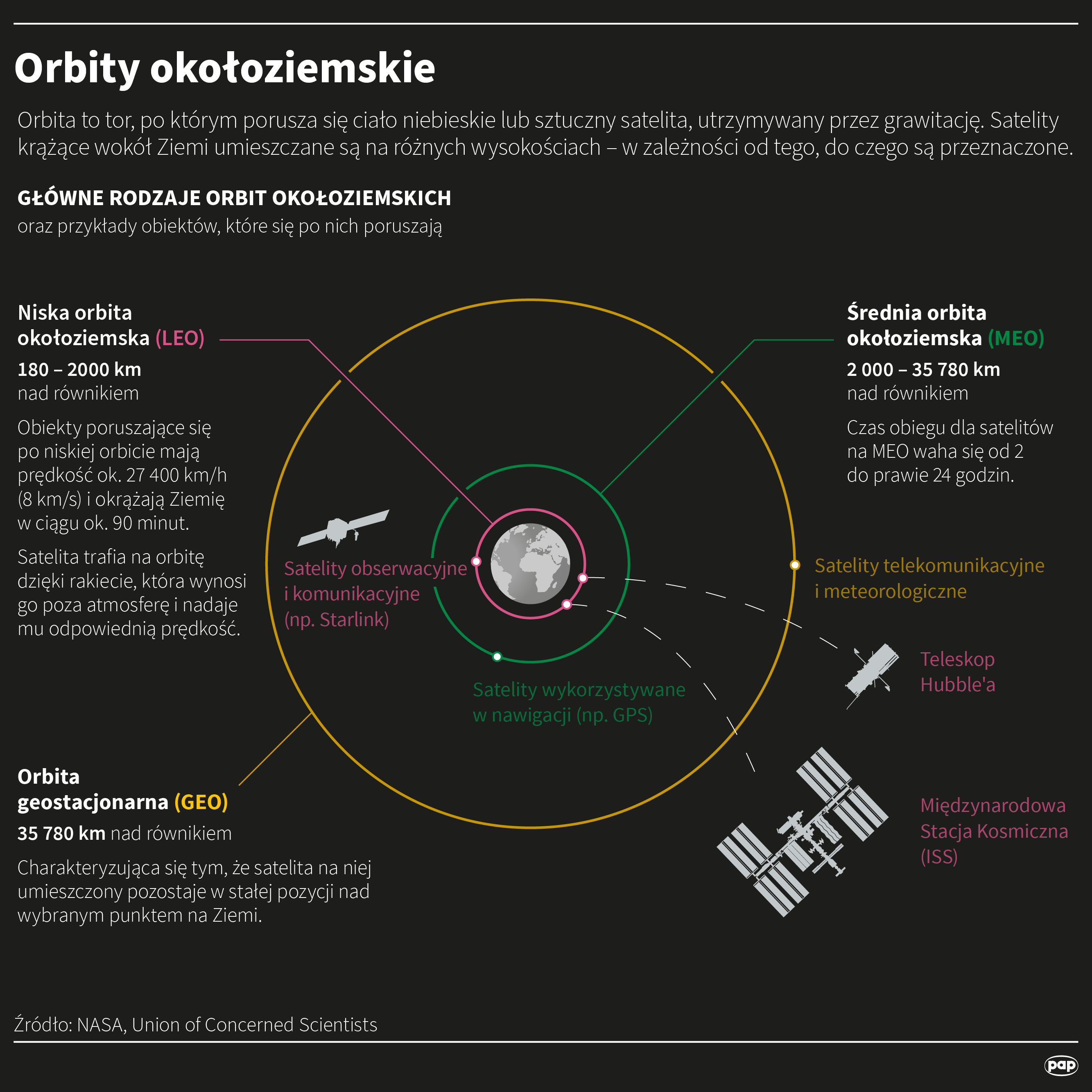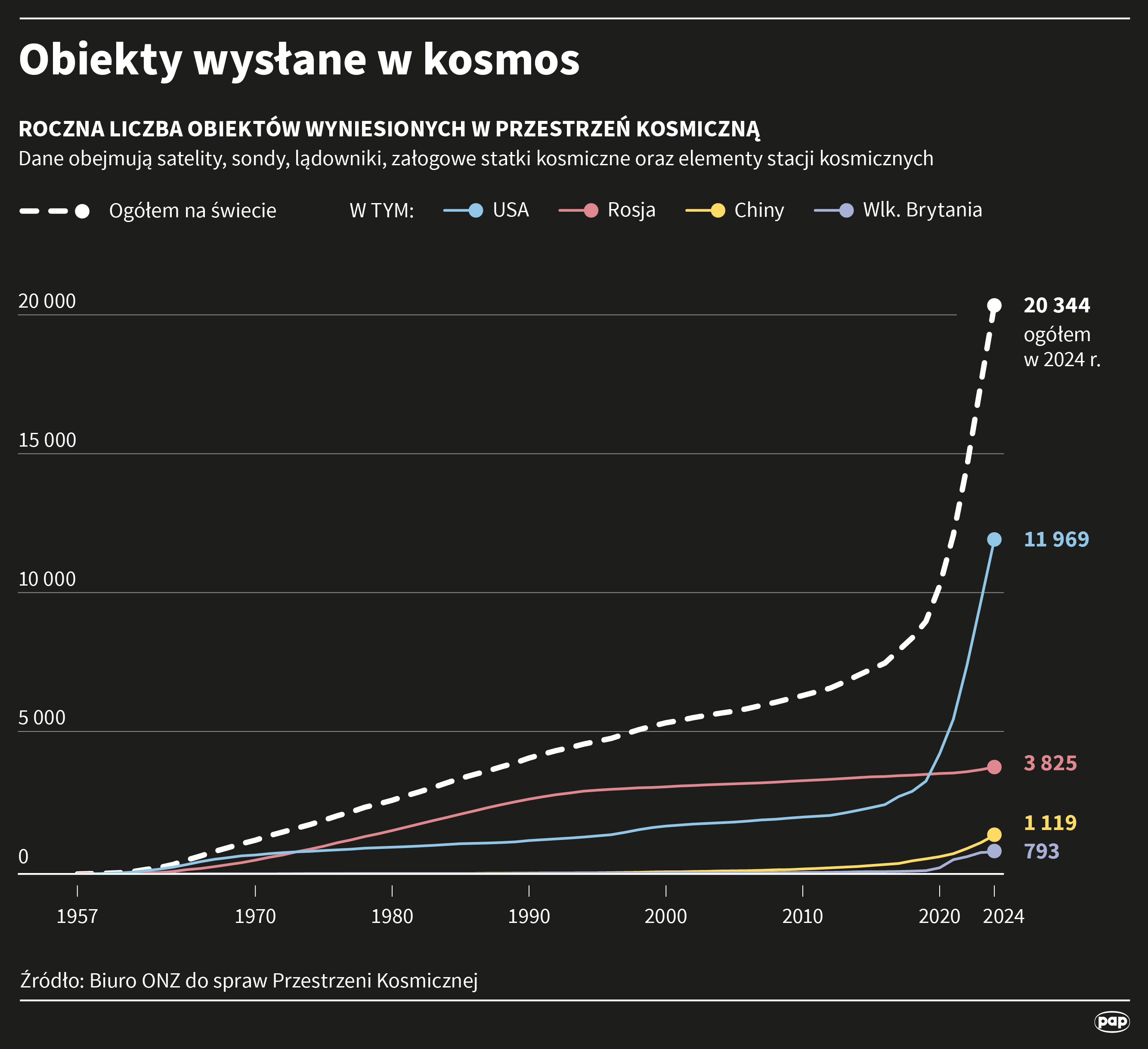CBK PAN expert: despite the crowds in orbit, there is still plenty of space

In the last six months, Starlink satellites have performed approximately 150,000 maneuvers to avoid collisions. Tens of thousands more satellites will soon be launched into low Earth orbit. Overcrowding may be a concern, but there's still plenty of space, assesses Dr. Tomasz Barciński from the Space Research Center of the Polish Academy of Sciences.
Low Earth Orbit (LEO) is the region between 200 and 2,000 km above Earth. This is where most manned spaceflights take place. Among other things, the International Space Station (ISS) orbits in LEO. Objects in low Earth orbit have a speed of about 27,400 km/h (8 km/s) and orbit the Earth every 90 minutes.
Due to the growing number of satellites in LEO, the question arises, among other things, what is the limit of orbital filling and whether we are approaching it.
"That's a good question, but it's difficult to give a clear answer. If we consider the extreme case of avoiding any collisions without having to maneuver the satellites, we've already exceeded that limit. Collisions do occur. However, if we allow for a small risk of collision and the option of maneuvering the satellites, the situation changes dramatically," Dr. Barciński, a specialist from the Space Research Centre of the Polish Academy of Sciences, told PAP.
As he describes it, it's like comparing a city where drivers don't look where they're driving and we want to avoid accidents, with a city where every driver is well-trained and we accept that accidents sometimes happen.
"It's difficult to say with certainty whether we still have a lot of space in orbit or not. There are no clear expert opinions on this matter. However, assuming some small risks and the use of various technologies, it seems we still have a large orbital ocean to exploit," explains Dr. Barciński.
He cautions that, for now, we are not at risk of the dangerous chain reaction known as the Kessler effect. This occurs when space debris collides with each other and breaks apart, creating ever-new and increasingly smaller pieces.

"This is a theoretical possibility, in which collisions or explosions in orbit create debris that shatters other satellites and other objects, creating more debris. This creates an avalanche effect, which eventually fills the entire orbit with fragments of shattered satellites and other objects. We don't see this process yet, but it's possible that we're simply at a very early stage of this phenomenon. Then, nothing will be visible for a long time, and then an unstoppable chain reaction will begin," the expert describes.
- In order to continue operating in orbit, we would have to develop some completely unknown technologies or produce armored satellites and stations - he adds.
Low orbit would then become unusable for humanity for a long time.
"The orbit will clear itself. In LEO, there are still some air molecules in the atmosphere that slow down all objects and cause them to re-enter the atmosphere. However, this takes a long time. Such orbit clearing would likely take decades. Meanwhile, our civilization is already highly dependent on satellites," the expert emphasizes.
To avoid problems and ensure the smooth operation of the growing fleet of orbital objects, appropriate technologies will be crucial.
"Most satellite evasive maneuvers don't affect the operation of these devices. Such events are, one might say, transparent to us," says Dr. Barciński.
In orbit, we also encounter so-called space debris, which is mainly created from the disintegration of satellites or rocket parts, technically known as fragmentation.
"We're talking about collisions, but also explosions. A section of the rocket, still containing fuel, can explode. Even a battery in a satellite can explode. Such situations are much more common than collisions. Both collisions and explosions create a cloud of fragments of the object, somewhat resembling Saturn's rings. Much of the debris is monitored from Earth, but this isn't possible for all of it, as some are too small. Additionally, some satellites can independently observe the space around them and, if necessary, conduct appropriate maneuvers," he explained.

One of the key elements of maintaining orbit in a usable condition will be the deorbiting of used satellites.
"To reduce the congestion in low Earth orbit and the associated risks, agreements have already been signed that define the end of life for each object sent into orbit. They must either deorbit or, if they have enough fuel, ascend to a very high, so-called graveyard orbit," said Dr. Barciński.
LEO crowding also means increased risk for space stations like the ISS.
"Satellites are typically located at an altitude of around 500-600 km, the ISS at around 400 km, and the Chinese Tiangong station even lower. However, problems may arise when thousands of satellites located slightly higher reach the end of their lives. Therefore, the stations will also have to perform evasive maneuvers more frequently," the expert explained.
Other approaches to the problem are being considered.
"Work is also underway on using orbits even lower than those used by space stations. However, here, friction with the atmosphere is relatively strong. Furthermore, it varies significantly depending on solar activity, which means significant instability. So-called pseudo-satellites are also being considered – for example, aircraft gliding at very high altitudes. They can hover over a given area for long periods and function as satellites. Further technologies that will help secure the possibility of operations in and near orbit will undoubtedly increase in number and become increasingly refined. Therefore, this orbital "ocean" I mentioned will likely continue to expand for us for a long time," said Dr. Barciński.
Marek Matacz (PAP)
mat/ bar/ amac/
naukawpolsce.pl




